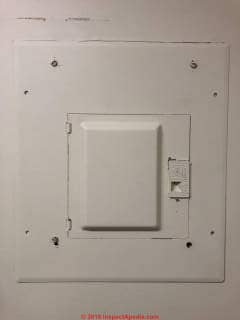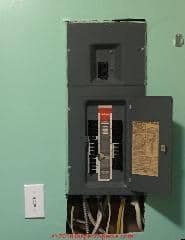 FPE Stab Lok circuit breakers & electrical panel Identification FAQs
FPE Stab Lok circuit breakers & electrical panel Identification FAQs
Q&A on proper identification of FPE Stab-Lok panels & breakers
- POST a QUESTION or COMMENT about identifying FPE Stab-Lok® and Federal Pioneer electrical panels and circuit breakers and about their associated hazards, testing, failure rates
Here we describe how to reliably identify FPE Equipment:
How to identify Federal Pacific Electric FPE Stab-Lok® electrical panels and circuit breakers.
Find here: Photo guides to identification of Federal Pioneer Stab-Lok® electrical panels and circuit breakers, Photo guides to Federal NOARC load center identification, and Photo guides to identification of Federal Electric panels and circuit breakers.
This article series describes how to identify Federal Pacific Stab-Lok® Electric Panels and circuit breakers in buildings.
This FPE information is for building inspectors, home buyers, home owners, electricians exploring the background of possible hazards associated with Federal Pacific Electric Stab-Lok® circuit breakers and service panels.
Replacement FPE Stab-Lok® circuit breakers are unlikely to reduce the failure risk of this equipment. We recommend that residential FPE Stab-Lok® electrical panels be replaced entirely or the entire panel bus assembly be replaced, regardless of FPE model number or FPE year of manufacture. We do not sell circuit breakers nor any other products.
InspectAPedia tolerates no conflicts of interest. We have no relationship with advertisers, products, or services discussed at this website.
- Daniel Friedman, Publisher/Editor/Author - See WHO ARE WE?
Q&A on How to Iidentify Federal Pacific Stab-Lok® (FPE)
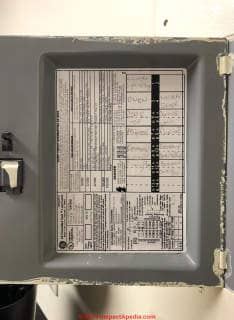 These questions & answers about proper identification of Federal Pacific Stab-Lok® electrical panels were posted originally
These questions & answers about proper identification of Federal Pacific Stab-Lok® electrical panels were posted originally
at FPE & FP IDENTIFICATION, HOW TO - be sure to see 4 easy Stab-Lok identification steps given there.
All of the FPE Stab-Lok® equipment, electrical panels and circuit breakers sold and installed in the U.S. suffers the no-trip breaker and other problems across all residential equipment models and ages.
Photo: a General Electric Load Center panel label: this is NOT an FPE product, as we will explain below.
On 2019-08-24 by (mod) -
Thank you for the follow-up photo, Casey; yes that's a GE panel, breakers, and bus, not a Federal Pacific Electric / FPE Stab-Lok.
Options are to either replace that panel with a new one that provides a main breaker or to have an electrician install a main breaker in a separate box jext to or just "ahead" of (electrically) the panel.
On 2019-08-24 by Casey - GE Electrical Panel Interior Photo
A different electrician came to my home to look at the panel. He was able to get the panel cover screws on, but the heads are flush. He removed the panel to look at the circuit breakers and tightened a couple of connections.
The inside has TLM1212, which corresponds to the panel cover sticker so I'm not sure where the first election thought it was an FPE panel. I took a photo while the panel was off. Regarding the lack of a main switch, my previous 2 condos didn't have one inside the unit either.
This unit was constructed in 1982 so if this the original sub-panel it may be getting time to replace it with one that has a main breaker. I'm on the 15th floor and the mechanical room is in one of the basement levels.
On 2019-08-17 by (mod) -
Casey
If there is no main switch that turns off all of the breakers in your panel that is ALSO next to the panel or within a foot or two of it and labeled MAINS, it'd be far safer (and code compliant) to have one installed.
If someone is being electrocuted or smoke's coming out of the wall you don 't want to delay turning off the power to fool with ten or twenty breakers. One switch turns it all off.
See https://inspectapedia.com/electric/Main_Electrical_Disconnect.php
On 2019-08-17 by Casey
Thanks Dan. The condo I previously owned didn't have a main breaker either; it might be in the building's mechanical room. I am going to call another electrician on Monday to get a second opinion and at least install filler plates and correct the panel alignment.
On 2019-08-17 by (mod) - GE General Electric circuit breakers, bus, cover in an old FPE Box?
Everything we can see in our photos is GE - General Electric circuit breakers, label, panel cover. It's possible that an electrician previously gutted an FPE electrical panel box and retrofitted all GE parts into the enclosure. GE panels and breakers and bus designs are NOT of the FPE Stab-Lok design and have nothing to do with the Stab-Lok safety and performance hazards.
However as our discussion points out, your photos raise various questions about your GE Panel.
Yes you can find plastic snap-in covers for the open breaker slots.
Missing from your photos is a main switch that turns off the entire panel; when you have more than 6 breakers a main is necessary. It may be in adjacent box labelled "MAIN"
The GE electrical panel label inside the door identifies this product as a
GE Power-Mask Gold Load Center TLM12BD
It's highly unklikely that any FPE components remain inside the panel but we can't see inside it yet. From your description we INFER that the panel guts were replaced in an effort to remove any FPE hazard.
Watch out: a view of the panel interior to show exactly how it is assembled and what components are present can confirm the presence or absence of ANY Federal Pacific Electric FPE components - we can't see inside the panel from your photos. A licensed electrician or home inspector should know how to open the panel cover safely. Don't fool around with it yourself as you could be shocked or killed.
It's possible that an old FPE label or some other clue caused the people involved to make the FPE comment you heard - more details would be helpful.
On 2019-08-17 by Casey
The electrician said the panel cover holes being used are not original, which explain why the bottom two don't align with the interior case.
The home inspector suggested going to Home Depot or Lowes to get fillers to cover the open panel slots.
On 2019-08-17 by (mod) - Photo identifies a GE General Electric Panel - this is NOT a Stab-Lok FPE design nor product
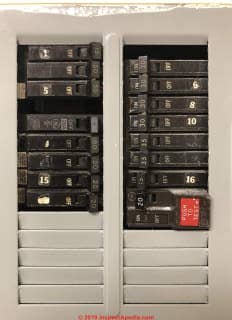 I can't figure this out from your question, photo, and the remark:
I can't figure this out from your question, photo, and the remark:
"... electrical panel is a Federal Pacific and a GE panel was installed over it."
A GE circuit breaker will not fit into nor connect onto an FPE electrical panel bus bar.
Perhaps just the metal box that once held an FPE panel is what's installed?
The breakers in your photo are GE type breakers not FPE / Federal Pacific Electric Stab-Lok products..
There are other hazards and improper conditions such as open panel cover slots.
Photos of the panel labels, cover, door and any markings that support your electricians Federal Pacific Panel statement would be helpful .
On 2019-08-17 by Casey
I recently moved into a new home. During the home inspection, the inspector noticed two screws on the panel cover didn't fit correctly and suggested longer screws and to install filler plates to cover areas were knocks out were removed.
An electrician came over yesterday to look at another issue, but I asked home about my electrical panel since after buying longer screws I noticed the panel holes did not align correctly with the box. The electrician said the electrical panel is a Federal Pacific and a GE panel was installed over it.
I don't see Federal Pacific Electrical or FPE anywhere on the panel though. This high rise condo was constructed in 1982 so it does seem possible. Did the electrician correctly identify this panel as FPE?
On 2019-05-16 by Anonymous - I was taught to never open a Stab-Lok Electrical Panel - is this one of those?
 RE-posting from private email:
RE-posting from private email:
Anonymous by email said:
Hello and thank you for your past help.
I understand you did a lot of research on FP panels.
I'm just trying to confirm that NON Stab Lok panels, do NOT have the same issues as the Stab Lok panels. Would this be correct?
I have attached a photo of the panel of my concern.
As I understand or have heard second hand, some insurance companies still avoid insuring PC panel equipped homes even if they are not of the Stab Lok design.
Would you be able to advise me about this?
I am trying to determine if I should mention this non stab lok panel in the home inspection report.
Thank you very much, - Anonymous by private email 2019/05/16
Moderator Reply: all FPE Breakers/Panels are Stab-lok
If you are asking about FP or FPE electrical panels, there are no models that are not the Stab-lok design except for the company's fuse panels. The panel in your photo is labelled FPE / Federal Pacific. I agree that the words "Stab-Lok" don't appear on the panel label, but this is a Stab-Lok design.
If you are trained to safely remove the panel cover and inspect the panel buses inside you'll doubtless see the characteristic E-shaped or F-shaped openings in the panel bus.
See details at FPE & FP IDENTIFICATION, HOW TO where you'll find a lengthy list of methods to identify this equipment.
If you open the panelI'd like to see a sharp photo of the panel bus and of any other labels that may be inside the box.
Reader Follow-up: I was trained to remove panel covers but we were always told if it’s federal Pacific stab lock, don’t open them up!
Thank you, I was trained to remove panel covers but we were always told if it’s federal Pacific stab lock, don’t open them up!
So I don’t . They told us that the breakers could pop out at you and get loose.
Moderator Reply: dangers of refusing to open a Stab-Lok Panel & Dangers of Opening Any Electrical Panel, Especially Spring-Loaded Panel Fronts
We might want to discuss this topic with greater care.
1. In general you can assume that if it's a circuit breaker and it's FP, FPE, Federal Electric, etc. it's a Stab-Lok design - as our article series documents and illustrates.
So you do not need to open the panel just to make that determination.
Certainly some high-volume inspection companies and training schools look for every opportunity to simplify and speed the process. In my OPINION that's not always smart - as it risks
exposing an occupant or buyer to a life/safety hazard that is not observed, not reported, not disclosed. A disclaimer won't prevent an injury, fire, death nor stop a lawsuit about such.
2. ASHI, and various state licensing standards expect the inspector to open the electrical panel unless s./he has a specific observation that in her/his judgement makes touching the panel unsafe.
Why? Because in addition to the defective product issue there can be other immediate life safety concerns that might be observed therein such as
- aluminum wiring
- evidence of overheating
- over-fusing
- mis-wiring
- missing ground connections
and a host of other faults that cannot be seen with the panel covered
I certainly don't want you to get shocked or killed by touching an unsafe panel, but on the other hand, JUST because a panel is labelled FPE or FP is NOT justification for declining further inspection.
Also in my OPINION (empahsizing it's an opinion not a research-supported fact) we ought not be ducking the issue by saying "have the panel inspected by a licensed electrician" since too often local electricians are the very folks who installed the panel in the first place; some of those don't know about these hazards.
Besides if we refer everything to an additional level of onsite inspection the client with any sense will wonder what the heck they paid their home inspector for in the first place.
So I (mostly) disagree with whomever conducted your training on this point. My experience in standards, ethics, certification exams, licensing, education, as well as home inspection, construction, and electrical wiring all lead me to a different opinion.
Loose Stab-Lok Breakers vs Loose Other CIrcuit Breaker Brands
Watch out: however I agree that SOME FP circuit breakers do not mount securely in the electrical panel. In a Toronto home, for example, I saw breakers held in place in the panel with Scotch Tape. The tape and the loose breakers were plainly visible *without* having to remove the panel cover, and you and your trainer were dead right that such panels are dangerous.
I have in fact reported on an electrician (in Georgia if I recall right) who was killed when he removed a panel cover - an arc explosion from loose breakers blew out and killed him.
However, that was NOT an FP/FPE electrical panel, and it WAS a panel using a spring-loaded faceplate that, combined with a frame, pushed on the circuit breakers, holding them against the panel bus assembly.
Electrical Panel Cover Removal Dangers
What this means to me is that loose breakers are NOT specifically an FPE Stab-Lok or FP or FP panel issue, they are an issue in ANY electrical panel and something to watch for,  And it means that when you see ANY electrical panel faceplate that uses a spring loader you should be very careful when removing the panel cover to watch for loose, moving breakers. If you're in doubt don't touch the panel at all, explain the concern to your client, and then I agree it's reasonable to have a more-trained electrician check out the panel.
And it means that when you see ANY electrical panel faceplate that uses a spring loader you should be very careful when removing the panel cover to watch for loose, moving breakers. If you're in doubt don't touch the panel at all, explain the concern to your client, and then I agree it's reasonable to have a more-trained electrician check out the panel.
The mistake here was
1. tarring all FP panels with the "loose breaker" brush - that's basically wrong
2. failing to point out how to recognize the spring loading panel faceplate panel hazard
3. failing to point out how to recognize other signs of loose breakers in a non-spring-loaded panel faceplate
Please don't take offense, I'm grateful for your question and want you and your customers to be safe.
See details at REMOVE ELECTRICAL PANEL COVERS
See this ELECTRIC PANEL INSPECTION SAFETY advice and hazards
Above is a Square-D electrical panel cover illustrating what I describe as a "spring-loaded" electrical panel cover plate.
Question: my parents never had a problem with their FPE panel and don't plan to replace it
(Mar 30, 2012) Paul Stevens said:
My parents have a PFE panel that has been in their house for years. The house is so old that is has the original cloth sleeved wiring. They have never had the first problem with these breakers. ANY brand breaker can malfunction.
This company no longer exists. I would only hope that existing companies did not target PFE with negativity to gain market share. My parents have no intention to change out their panel. And no, there is not a cause to wish them good luck.
Reply:
Your parents are not required by law to change out their electrical panel. But "never having had a problem" is not the slightest indication that the electrical panel and its breakers are "safe" . We do not encourage panel replacement as a "panic" repair - doing so invites gouging and unnecessary costs. We do recommend panel replacement. Stay calm.
- Understand latent safety hazards: First, the circuit breakers that are never called-on to protect against an over-current never show any failure. Imagine riding around in your car with a seat-belt that has been cut to a mere thread down near the floor attachment where you don't see the defect. The seat belt buckles just fine, and looks just fine. And it's worked perfectly up to now.
But, then, you've not been in a car crash either. This is an example of a latent safety defect. The defect doesn't initiate a failure, it simply fails to protect you should a failure occur in the system. - Second: stays live: even jammed FPE circuit breakers (a condition that happens on a 2-pole breaker that suffers an overcurrent on one leg) that are absolutely not going to trip when the next over-current occurs will continue to pass-on electrical power to the circuit just fine. "Working" in that sense means "passing on electricity" which should not be interpreted to mean "safe".
- Third: false-off: some of this cohort of circuit breakers remain "on" when apparently switched "off" - a dangerous condition that is not visible and not detected - until something else happens.
On 2018-12-01 by (mod) - recommended replacements for Stab-Lok panels and breakers
Nelson
Check the ARTICLE INDEX near the end of this article and you will see in that list a series of articles on replacement electrical panels. There are several options.
On 2018-11-30 by nelson-terra@outlook.com
How can I find recommended replacements for Stab-Lok panels and breakers?
On 2018-11-13 by Vince
Got it, thank you!
On 2018-10-18 by (mod) - Identify FPE Stab-Lok breakers made in England
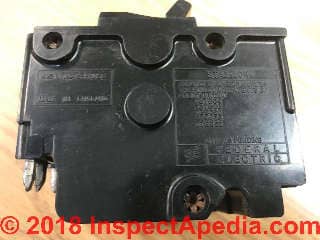 Andy
Andy
Please see your question repeated along with a more-detailed reply now found at
FEDERAL ELECTRIC PANELS UK Stab-Lok
On 2018-10-16 by AndyMac
I found this strange breaker that says it was made in England and wanted to know if anyone else has come across these breakers before. Says its 415VAC 3Ø and has stabs that to be honest look like Batman...
On 2018-05-03 by (mod) - replace FPE Sub-Panel
Sorry Kim, your electrician is right and is being safe.
I agree that you get SOME protection from a reliable main breaker in that in an extreme dead short in the FPE sub panel, the GE main ought to trip.
But the GE breaker in the main panel won't prevent a fail-to-trip in the sub panel and thus can't prevent a shock or fire occuring in circuits that are downstream from the FPE box.
I would replace the FPE sub panel. If you want to contribute the breakers for testing and research I'll pay the shipping cost to send them to me or to Dr. Aronstein.
InspectAPedia is an independent publisher of building, environmental, and forensic inspection, diagnosis, and repair information provided free to the public - we have no business nor financial connection with any manufacturer or service provider discussed at our website. We do not sell products nor services.
On 2018-05-03 by Kim
We have a GE main breaker in the house. We had an electrician out yesterday to install a pool heat pump outside the pool house and he said since the pool house has a FPE Stab Lok breaker he will not install the pump and says it needs replaced. I read on one site that since the main breaker is not Stab Lok, it would provide a backup trip if the stab lok doesn't trip on overload. Is that true? Do we need to replace the secondary breaker? It runs one light, pool pump and hopefully a pool heat pump.
Reader comment: our electrician says our FPE box needs replaced
(July 8, 2012) Laura said:
We are moving into a 1940's house and needed some electrical work for a kitchen remodel. Our electrician took one glance at the box and said it needed to be replaced since it was unsafe and suggested I do the google research to confirm his opinion. After reading this information I agree and we will be replacing the box. The lives of our family isn't worth saving a few dollars to try and keep something that is potentially dangerous.
Reply:
We agree, Laura. - Ed.
Reader comment:
(Sept 27, 2012) Anonymous said:
Here are some great videos by geoff williams on how to identify federal pacific stab lok panels. www.youtube.com/watch?v=FBqa8yDHAlo
www.nbcbayarea.com/investigations/
Reader comment:
(Jan 8, 2013) John Mlueller said:
Regarding the Federal Pacific panel that was not known to you, That one was a Multi-Breaker design that was made and installed in the 1950's and possibly earlier. My father rewired our 1905 San Francisco home in 1952, and the main breaker box was with a 200A main and this style of branch breakers and Federal Pacific brand
. I believe the same style was interchangeable with Square-D Multi-Breakers of that era, just as the old XO series of breakers were interchangeable between Square-D and Cutler-Hammer (before they went their separate ways with the QO and CH series).
You would specify the ratings of the breakers installed--single poles, double poles, and install them in (I believe) units of 4-pole spaces at a time. I don't recall the details of the bus-work on these.
Reply:
No, John, Square-D and Cutler-Hammer circuit breakers do not swap into an FPE electrical panel - the bus designs are different.
These questions & answers about how to identify FPE Stab-Lok or Federal Pacific or Federal Pioneer or Federal Electric circuit breakers and electrical panels were posted originally
at FPE & FP IDENTIFICATION, HOW TO where you will find the first in a series of FPE-ID articles.
On 2017-12-20 by (mod) - replace FPE Stab-Lok circuit breaker panels
For a simple explanation of why you should replace an FPE panel see SUMMARY of the FPE Stab-Lok® HAZARD
For a technical explanation of the hazard and supporting test and research results see Dr. Jess Aronstein's FPE HAZARD REPORT - 2017 [PDF]
Update: HAZARDOUS FPE CIRCUIT BREAKERS AND PANELS - 2024 [PDF] independent research article by Jess Aronstein, supercedes older FPE hazard reports by this author.
On 2017-12-20 by Christine Dougherty
Does this need to be replaced? Is it not safe, as I have read.
On 2017-09-27 by (mod) -
Thanks Joe but to protect our readers' confidence and trust we do not permit posting of advertisements as comments.
On 2017-09-27 by (mod) -
RE-posting
Joe JRL Electric Supply Inc said:
Here is a link to identify your FPE breakers with pictures
FPE & FP IDENTIFICATION, HOW TO
On 2016-11-21 by (mod) - No stickers on the box. If I sent a picture do you think you could identify it?
Yes, but a certain identification can be made if you have a qualified electrician simply open the panel and inspect the bus. The bus -- that's the bar into which the breakers connect - is one of 3 designs unique to FPE.
If you click on ARTICLE INDEX to FPE STAB-LOK BREAKERS & PANELS
above you'll see various ways to ID FPE breakers and panels.
Use the page top or bottom CONTACT to find our email to send photos.
On 2016-11-21 2 by Angela Olberding
No stickers on the box. If I sent a picture do you think you could identify it?
On 2016-11-21 by (mod) - need a "dead front" cover for an FPE panel box
Angela,
We need to understand first exactly what's missing. If the inspector means there are openings in the panel where breakers were removed, there are standard plastic snap-ins for that location.
If the whole interior cover is missing so that opening the panel door shows exposed wiring, that's a serious shock hazard for the next homeowner.
You may find a replacement interior cover from the panel manufacturer: you'll need the brand and model - stickers are located (we hope) on the interior of the hinged panel cover door and/or on stickers inside the panel itself.
If the panel is an unreliable one such as some of the brands I list above, you might prefer to let your buyer replace the panel, giving an allowance if you agree to do so. That wastes the least of the communities' money, as often where there's an obsolete or old panel, the new owner actually would like a larger-capacity one anyhow.
Keep in mind that a home inspector is not a code authority and has NO authority to demand that you do anything.
A local building code inspector, on the other hand, is such an authority, and the hassle is that if there are code issues on a house being sold, that could hold up the buyer's ability to obtain a mortgage.
On 2016-11-21 by Angela Olberding
I am selling my house and the inspector found that we do not have a dead front panel and it must be replaced. How do I go about finding the right one?
On 2015-10-27 y Marc N9KHI
I just rewired the house (circa 1939), removing/replacing the old cloth covered rubber wire with modern THNN and replaced an old breaker panel. This panel is a dead ringer for the FPE model 020/024 shown in photographs on your site but it is made by Square D and is called a "Multi-Breaker".
Otherwise, appearances are identical. I still have the breaker assembly and panel cover plate and it is in decent enough condition to get some good quality pictures if you folks want them for archives. Advise an email address that I can send pictures of fair size and resolution (large files) if you want them.
Amperage of each pole is stated on the side of the individual actuator handles.
On 2015-07-01 (mod) - how to determine the ampacity of a Stab-Lok panel
On 2015-07-01 by Clayton
How do you tell the Amperage of a Stab-lok panel?
On 2015-04-30 by (mod) -
Rob
I don't mean to imply, rather to report.
Despite having asked FP by telephone and having spoken to an engineer with the company, following that question years ago we have no reply from the manufacturer to a question of what if any changes were made to the earlier FP design.
We have not had as many failure reports from Canadian installations as from those in the U.S. but keep in mind that there can be various explanations for such differences:
- differences in the product (apparently not)
- differences in installation workmanship
- differences in propensity to report failures
- differences in lifestyles, frequency of overcurrents
- the list could be quite lengthy. So this is just to say don't assume. We'd need to see independent lab tests of current and older FP breakers.
On 2015-04-30 by Rob
Are you implying that all federal pioneer breakers may be faulty rate up to the present time.
Rob
...
Continue reading at FPE & FP IDENTIFICATION, HOW TO - topic home, or select a topic from the closely-related articles below, or see the complete ARTICLE INDEX.
Or see these
Recommended Articles
- FPE & FP IDENTIFICATION, HOW TO
- HAZARDOUS FPE CIRCUIT BREAKERS AND PANELS - 2024 [PDF] Final Report - independent research article by Jess Aronstein, supercedes older FPE hazard reports by this author.
Suggested citation for this web page
FPE & FP IDENTIFICATION FAQs at InspectApedia.com - online encyclopedia of building & environmental inspection, testing, diagnosis, repair, & problem prevention advice.
Or see this
INDEX to RELATED ARTICLES: ARTICLE INDEX to FPE STAB-LOK BREAKERS & PANELS
Or use the SEARCH BOX found below to Ask a Question or Search InspectApedia
Ask a Question or Search InspectApedia
Try the search box just below, or if you prefer, post a question or comment in the Comments box below and we will respond promptly.
Search the InspectApedia website
Note: appearance of your Comment below may be delayed: if your comment contains an image, photograph, web link, or text that looks to the software as if it might be a web link, your posting will appear after it has been approved by a moderator. Apologies for the delay.
Only one image can be added per comment but you can post as many comments, and therefore images, as you like.
You will not receive a notification when a response to your question has been posted.
Please bookmark this page to make it easy for you to check back for our response.
IF above you see "Comment Form is loading comments..." then COMMENT BOX - countable.ca / bawkbox.com IS NOT WORKING.
In any case you are welcome to send an email directly to us at InspectApedia.com at editor@inspectApedia.com
We'll reply to you directly. Please help us help you by noting, in your email, the URL of the InspectApedia page where you wanted to comment.
Citations & References
In addition to any citations in the article above, a full list is available on request.
- In addition to citations & references found in this article, see the research citations given at the end of the related articles found at our suggested
CONTINUE READING or RECOMMENDED ARTICLES.
- Carson, Dunlop & Associates Ltd., 120 Carlton Street Suite 407, Toronto ON M5A 4K2. Tel: (416) 964-9415 1-800-268-7070 Email: info@carsondunlop.com. Alan Carson is a past president of ASHI, the American Society of Home Inspectors.
Thanks to Alan Carson and Bob Dunlop, for permission for InspectAPedia to use text excerpts from The HOME REFERENCE BOOK - the Encyclopedia of Homes and to use illustrations from The ILLUSTRATED HOME .
Carson Dunlop Associates provides extensive home inspection education and report writing material. In gratitude we provide links to tsome Carson Dunlop Associates products and services.



